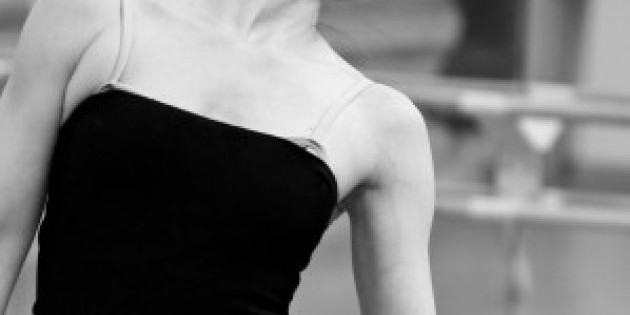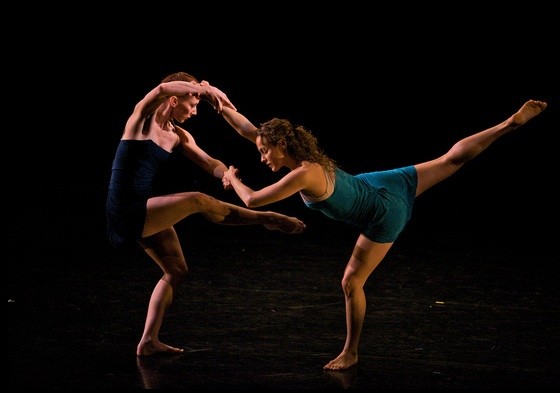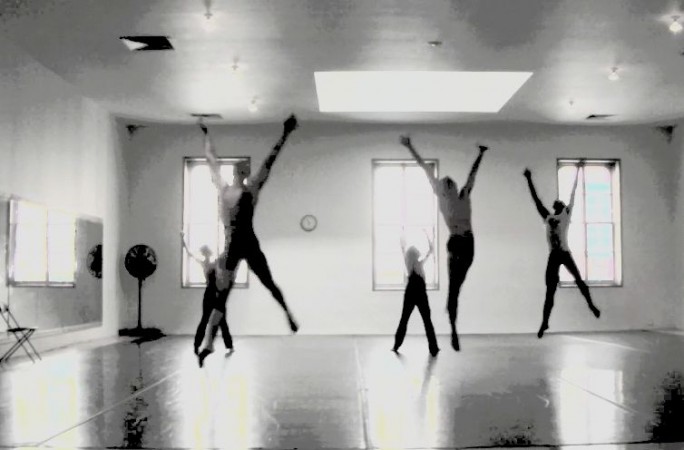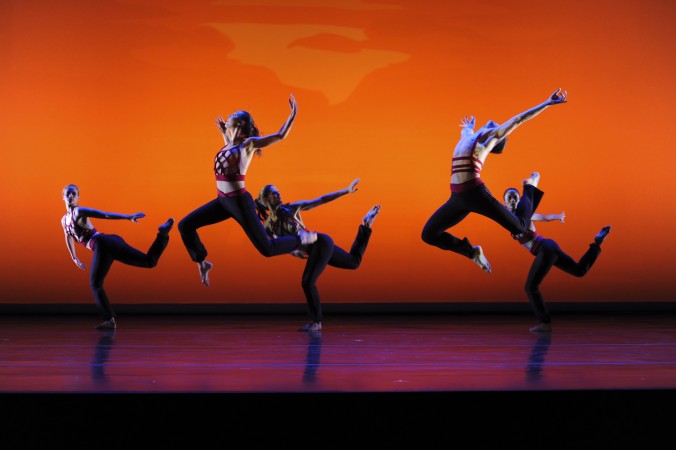THE DANCE ENTHUSIAST ASKS: BLAKELEY WHITE-MCGUIRE

BLAKELEY WHITE-MCGUIRE, A MARTHA GRAHAM PRINCIPAL DANCER, CHOREOGRAPHER, AND FREQUENT CONTRIBUTOR TO THE DANCE ENTHUSIAST, ANSWERS SOME QUESTIONS ABOUT HER NEWEST CREATION
THE DANCE ENTHUSIAST ASKS : BLAKELEY WHITE-MCGUIRE...
©Christine Jowers 2011
Blakeley White-McGuire shares with us excerpts of her newest choreographic endeavor These Worlds In Us and discusses her process, her motivations, her thoughts on favorites, and more...
How long have you been choreographing? Dancing?
I have danced and made dances since childhood and cannot recall a time without either. Dancing and performing have always been, for me, a connection to my community; making dances is a huge part of that expression.
Do you remember you first dance job?
As a teenager in my homestate of Louisiana, I would dance at Mardi Gras Balls. In New York, I think my first dance job was in a show called “When a Man Loves a Man.”
Good times.
The greatest influence on me as an artist though, is not one person.
I feel that my greatest influence is the legacy of dance artists past and present. I draw great inspiration and strength from choreographers who have and continue to rip their skin open and expose their inner being
How did creating These Worlds In US come about? Were you commissioned? Did the idea/ inspiration come first? Or did the piece evolve from studio work. What ideas were you playing with ?
I was offered sponsorship for a creative residency in 2010, by the extremely generous, forward thinking arts patron and dance lover, Mr. Geoffrey Fallon. At that time, I had become aware of American composer, Missy Mazzoli and her band Victoire and had had somewhat obsessive thoughts about creating a dance to live within her music.
The music came first for sure, it was my inspiration - even the title is taken from Missy’s composition, These Worlds In Us. The first time I heard the music, I also saw it - clear as day, what I wanted to express in movement. Not the physical movements but the content, the communication of the idea that we can never really “know” another person; that there are worlds in us - a metaphor for the inner life.
I did not wish to “celebrate the music” ( a quote from Robert Wilson) but I did allow my visceral responses to move me and shape the form to experiment with those responses to the music.
How did you chose your dancers?
I prefer to work with dancers whom I know in some way, either through dancing together or seeing them around the city in class or performances. The dancers in this film, Lloyd Knight, Jacquelyn Elder, Ben Schultz and Maurizio Nardi all dance with me in the Graham Company. They are some of the best out there, we share a common language and mutual respect for the form. I also invited some other dancers to be in the work but their schedules clashed - that’s why I danced in it.
You have been a Graham Dancer exposed to, not only, the masterpieces of Graham but work by Robert Wilson, Ann Bogart, and others. Do these creators come to mind when you are working as a choreographer? who have been your most profound choreographic influences?
Without a doubt, I am influenced by every artist I work with or whose work I study. The profound value of stillness is my greatest lesson from studying Graham as a performer and choreographer. Most recently, I had the distinct privilege to be in process with two different choreographer/directors, Robert Wilson and Bulayeruang Pagarlava within a week of one another. These artists were extremely different personalities and creators, but I absolutely saw commonalities in what they valued in generating movement and creating form for the stage.
The greatest influence on me as an artist though, is not one person - I feel that my greatest influence is the legacy of dance artists past and present. I draw great inspiration and strength from choreographers who have and continue to rip their skin open and expose their inner being through movement, staging, experimentation and collaboration with other human beings. Choreographers are so vulnerable - very few have the ability to demand anything of the greater world but they all demand what they can from themselves and their dancers. The striving, the continuing, the tenacity - all packaged in the most elegant, fascinating form in existence, our human body, mind and soul.
Do you have a Blakeley McGuire movement/art philosophy and underlying principle to what you do?
The heart of all of my work is listening to the inner rhythm, inner voice that is uniquely mine. The process of expressing that by generating movements, relationships, images in the dance, is one that I am still very much discovering.
What part of the performer do you find most interesting?
The inner life of the performer is what fascinates me. Dance, music, writing - it’s all just form for the revelation of the inner life. I don’t mean like therapy, I mean - revelation of what it is being in this world, on this Earth - alone - with others - uncertain - in communion, joyful. All of it. Is the dancer willing to be that vulnerable, are they even aware of it and can they use it to release movement into the physical world. I am curious as to what motivates them not in a chit-chat way, but in a visceral, instinctual way.
As a dancer/choreographer/ appreciator of dance, what part of the body do you find the most interesting/expressive?
A dancer’s musicality is like their fingerprint - no two are the same. I remember dancers more for their musical choices than their body parts. The eyes also have it. Focus reveals so much about a performer and it cannot be taught or trained.
Dance, music, writing - it’s all just form for the revelation of the inner life... I don’t mean like therapy, I mean - revelation of what it is being in this world- on this Earth - alone - with others - uncertain - in communion, joyful.
All of it.
What excites you about performance?
Performance completes the expression. The coming together of audience and performer is extremely personal and happens in the darkness and fully focused space/time of performance. There is no substitute for the real time relationship of performer and audience.
What doesn't?
Too much information - I don’t want anyone telling me how to experience art, dance, music - anything. It is personal.
Do you have favorite pieces that you have danced in or that you have watched as an audience member?
I am not big on favorites, in general. There is so much beauty and courage out there - I try to experience all that I can.
What is your process like? Do you spend time on research... do much work alone before presenting ideas and movement to your dancers?
So far, the only constants in my process are writing, research and drawing. I write a lot and spend time alone in the studio before I work with anyone else. This is also true of my work as a performer. So, I suppose that’s my process.
Is it difficult dancing in your own work?
I love dancing in my own work, but it is difficult choreographing when I am also dancing.
Is These Worlds In Us a piece for film solely, or will it be performed in concert?
My intention is to develop These Worlds In Us by another 10 minutes or so to more of Missy Mazzoli’s beautiful music and perform it in the theater. If you know of anyone who would like to help me make that happen, let me know.
Why did you chose to go from black and white to color?
I changed between color and black and white to emphasized the potential different realities in any given moment. My idea for the dance itself was that it’s impossible to know someone - really. I may think I know someone and how they are, but inside there could be a completely different being. It goes back to the inner life, I suppose.
Did you edit the piece or someone else?
I edited the piece myself, on my Mac using the footage I had saved. There is more choreography in the actual dance, I edited it to repeat some phrases for the rhythm of the camera.
How did you create this film... I remember you saying it was done with a camera place on the floor.... is that right...if so, wow.
Yes, I placed my video camera on the floor of the studio so I could study the footage at night in order to prepare for the next day’s work. It was purely functional, since I was dancing in the work. When I downloaded the footage onto my laptop, the images struck me as they danced across the screen and I just had to start working with it. I had no intention of making a film from it, I just needed to work with the footage.
If I asked the dancers, what would they say is something you always concentrate on in rehearsal... what are Blakeley isms?
Oh, you’d have to ask them that question.
Are you satisfied with this piece as it stands? Would you like to do something else with it? What were your challenges and joys in creating it?
This piece was a joy to create, in great part because of the people surrounding its development. Walking into a studio with nothing and walking out with something is rewarding - that “satisfaction of spirit” that Graham talked about. Also, our patron Geoff Fallon, who was very hands off - came in towards the end to be with us in the studio and experience the process, we all enjoyed that very much and shared in the fruits of the labor. I truly hope that this piece will be performed onstage before an audience one day soon.
Other than dancing/choreography what interests keep your mind and heart active?
My life is full with family and dance, but I also love poetry (obsessed with Wendell Berry right now), music, writing, fashion and just keeping up with world events and the state of our nation right here - especially our educational system.
Any advice for dancers or choreographers?
Keep going.
What do you do to keep your dancing and choreographic skills sharp and flowing?
I keep going- doing. I experiment and look for opportunities to try things outside of my known skill set. This can be embarrassing at times, but all of the most magical opportunities in life thus far have come to me from stepping off the cliff - being willing to play the fool, so to speak.
IS THERE ANYTHING ELSE YOU WOULD LIKE TO DO besides choreography and dancing --- a dream career or fantasy one... a hobby that you adore?
I would love to be able to play the fiddle in a band... to play well enough for people to dance to it:)

















